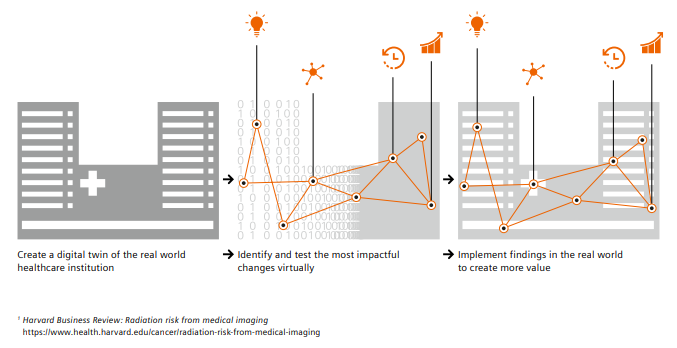Transforming care delivery in a single department
or an entire healthcare enterprise.


Executive Summary
Digital twin technology has proven its value in manufacturing, where use
of connected technology to monitor performance, model processes, and
optimize efficiency is already a mainstay of “Industry 4.0”. The link between
the physical and virtual worlds is a key facet of this emerging manufacturing
paradigm. Now, through the efforts of multi-disciplinary teams, hospitals are
creating four-dimensional digital twins of patient care units. They’ve realized
the value of running “what-if” scenarios for optimizing departmental
operations.
A digital twin can help healthcare enterprises identify ways to enhance and
streamline processes, improve patient experience, lower operating costs, and
increase higher value of care. The digital twin creates models of physical
spaces and processes. Then, cost and quality optimization parameters are
examined and ultimately selected based on the insights gained from
simulations leveraging the digital twin. Digital twins insights can be further
enhanced with complimentary technologies like Real-Time Locating Systems
(RTLS), which provides a robust data source and a means to test changes in
layout, process, etc.
A digital twin can have tremendous real-world impact. Mater Private Hospital
in Dublin, Ireland partnered with Siemens Healthineers to create a digital
twin of its radiology operations. The identified improvement potential was a
nearly half-hour reduction in patient waiting time, and significantly reduced
staff overtime costs.
The key to success of a digital twin is a strong partnership between the
hospital and a technology provider who understands the clinical, workflow,
and financial imperatives of healthcare providers. Siemens Healthineers
creates Value Partnerships with provider organizations in order to help them
create value and optimize care delivery.
This white paper will discuss the successful implementation of a digital twin,
and the vital role Value Partnerships play in building a digital twin.
Introduction
Simulations are commonplace in many work environments.
They help to identify strategies that work, and possible
avenues for improvement, without the time and expense
of rearranging real-world enterprises.
Simulations are especially important for complex,
high-risk and/or technical tasks. Aircraft pilots train on
simulators all the time. Medical students perform tasks
on simulation mannequins so that they can identify issues
with a technique in a safe, controlled environment.
A digital twin is a four-dimensional model (here, time
constitutes the 4th dimension) of a care unit, multiple
departments or even an entire hospital. A digital twin
links the physical and virtual worlds, turning data into
actionable insights. This is a key facet of the emerging
manufacturing paradigm known as Industry 4.0.

A digital twin enables healthcare providers to move assets
around, reconfigure departments, and see the effects of
changes to the simulated environment. Because it models
so many dimensions, the twin produces a detailed look
into how the hospital is working. The effectiveness of a
healthcare facility digital twin can be enhanced by
leveraging powerful data sources like Real-Time Locating Systems. RTLS tracks the movement of equipment, files,
even individuals, and can refine the twin’s accuracy in
simulating processes. RTLS data can also enable use of
the digital twin to predict the availability of equipment
and resources, and can rapidly assess the real-world effect
of changes suggested by simulations.
Key uses for digital twins in healthcare institutions
There are three primary domains where digital twins can
be effective in healthcare:
- Predicting the outcome of a specific scenario; perhaps a reorganization of the patient flow and clinical workflow in a specific department.
- Evaluating, on a quantitative basis, the impact of different layout scenarios, such as re-arranging waiting areas or distributing and splitting waiting areas for specific modalities.
- Performing operational stress testing on a department or an entire hospital.
“Simulation modeling is common when designing robust
production lines in various industries” notes Nicolai
Gossmann, Senior Management Consultant at Siemens
Healthineers. “The same idea can be applied to designing
efficient and patient-centric hospital operations. So, for
example, what happens if we have a very high incoming
flow of patients in the emergency department? That’s
a very specific scenario, but you can also evaluate
the operational impact of increasing patient demand
in certain services and its additional effects on assets,
utilization, staff, and more. The more handovers there
are in [a patient’s] journey, the more opportunities there
are to improve,” according to Gossmann.
Digital twins in medical imaging
Medical imaging facilities are in high demand. In the US,
for example, there are more than 80 million CT scans
performed annually1, and that number is continually
increasing. This huge demand for diagnostic medical
imaging is a logistical challenge for providers around
the world. How can they make the best use of space,
equipment, and staff to provide the best possible care
for patients? The value of a robust, high-fidelity
simulation in this situation is clear.
“We’re tracking the patient from check-in to reports being
furnished to the patient,” says Helen Calvey, Country Lead
Ireland, Enterprise Services for Siemens Healthineers.
“All of that information is put into the model. We come
up with a very patient-centered workflow.” By building
a dynamic model of a care facility, a provider organization
can identify and spread best practices in order to improve
efficiency, patient experience, and quality of care.
Partnership: The key to successful development
A partnership with multiple parties, both internal and
external, is necessary to make the digital twin work.
Clinical staff, hospital workers, receptionists, appointment
schedulers, administrative team members, hospital
architects, and a committed, qualified technology partner
all play key roles in creating an effective digital twin.
And that technology partner has to be much more than
a vendor. Healthcare organizations are looking for
guidance on how they can optimize performance, expand
capabilities, and advance innovation to deliver higher
value of care. Siemens Healthineers has developed Value
Partnerships, enduring relationships with healthcare
providers that help transform care delivery and create
higher value. The Value Partnerships framework enables
us to bring complimentary services – like digital twins
and RTLS – to bear for our partners.

Case Study: Mater Private Hospital
Mater Private Hospital in Dublin is one of Ireland’s
leading institutions for radiologic imaging and cardiac
care. The desire to update the hospital’s imaging fleet
and to maximize efficiencies in departmental workflows
led to conversations about the benefits of digital twin
technology between hospital management and longstanding partner Siemens Healthineers. “We were
running late on some evenings in order to accommodate
the increasing demand for medical scans,” said Associate
Professor Paddy Gilligan, chief physicist at Mater Private.
“That wasn’t ideal from a staff or patient point of view.
”
Gilligan said growing the size of the radiology department
in order to meet increasing demand for services was
difficult for several reasons, including space in a confined
city center location, not to mention the overall cost.
Leadership at Mater Private recognized the opportunity
to make the right changes by creating a digital twin
of the radiology department and partnered with
Siemens Healthineers to make it happen.
The combined Mater Private Hospital / Siemens Healthineers
Value Partnership team built a representation of current
radiology operations while working to review current
layouts and identify potential improvements. A one-week
on-site assessment was conducted, including workshops,
stakeholder interviews, and process observation. In the
end a digital twin was created allowing the partners to
run different scenarios and identify the best use of
equipment, and pressure test a physical layout.
Gilligan said the four-dimensional view of the
department unearthed heretofore hidden insights.
“We verified data at every step to be sure it was realistic,”
he explained. “Once the model was available, we could
run scenarios and see the value-add to changes we
make. We could also see the impact changes to layout
and operations have on other parts of the hospital.
Improvements that previously took months or years
of trial and error can now be achieved in a matter of days
or weeks.”
Some of the identified improvement potential from Mater Private’s digital twin include:
- Shorter wait times for patients – a reduction of 13 minutes for CT scans and 25 minutes for MRIs.
- Faster patient turnaround (arrival to departure) which shrank to 28 minutes for CT cans and 34 minutes for MRI.
- Increased equipment utilization – MRI usage went up by 32 percent and CT usage went up by 26 percent.
- Lower staffing costs, including 50 minutes less MRI overtime pay per day.
The most important benefit the partnership can bring is to improve patient experience.
The Mater Private digital twin shows how long the patient will spend at each stage of
their journey through radiology. This allows planning for waiting times in each section
maximizing the use of space and optimizing the patient experience.
Future applications
According to Sören Eichhorst, Head of Healthcare
Consulting and Transformation for Siemens Healthineers,
digital twin applications provide great opportunities in
healthcare. “You can apply it everywhere – e.g. in
radiology, lab, for interdisciplinary pathways or for
non-medical processes.”
Indeed, digital twin technology can yield efficiency and
patient experience benefits for almost every part of a
healthcare enterprise, including:
- Prostate Cancer treatment, where the victim interacts with multiple departments and disciplines.
- Cardiology operations – Mater Private performs more than 6,000 angiograms annually.
- Intensive care units, where a four-dimensional redesign of the overall operation can yield improved quality of care and greater operational efficiency.
Creating a digital twin represents a break with
established ways of doing business, yet it pays
tremendous dividends. “It takes a lot of dedication and
commitment to sign up for a digital twin application,”
said Calvey. “A healthcare partner can bring the
knowledge and commitment where the technology
partner can bring the technical expertise; together we
can make this successful.
”
Value Partnerships leverage evidence-based solutions
and tailor them to the situation at hand. In this case,
using a digital twin helped Mater Private plan the
modernization and expansion of their radiology
department armed with foresight on how to optimize
workflows, capacity, and patient experience. It is a good
example of how Value Partnerships create value for all
stakeholders.
Conclusions
- Digital twin technology is most effective in the context of a partnership.
- A high-fidelity, effective digital twin requires collaboration among hospital executives, clinicians, administrative staff, the building architect, and the technology partner.
- The multi-disciplinary team should continuously evaluate the digital twin to confirm it is delivering robust insights and enhancing efficiencies in hospital operations.
- Technologies like RTLS can provide a rich data source and significantly enhance the effectiveness of a digital twin model.
- With RTLS, changes made to layout or workflow from the digital twin simulation studies can be quickly measured for impact and success.
- A digital twin can help plan changes or expansion to care units, and minimize the need for costly changes after a department has been reorganized.
- Value Partnerships enable healthcare providers to leverage the clinical and technology know-how of Siemens Healthineers to create value for stakeholders.
To learn more about Value Partnerships click here or go to https://www.siemens-healthineers.com/services/value-partnerships
or read the full Mater Private case study at siemens-healthineers.com/mater-private-case-study
Latest Articles
clinical decision support, Siemens Healthineers, CDSS, health care quality, medical error, Computer-Based Clinical Decision Support System, The value of digital twin technology, Digital twins in medical imaging
The Value of Digital Twin Technology


























